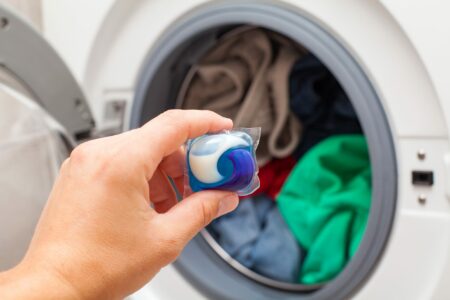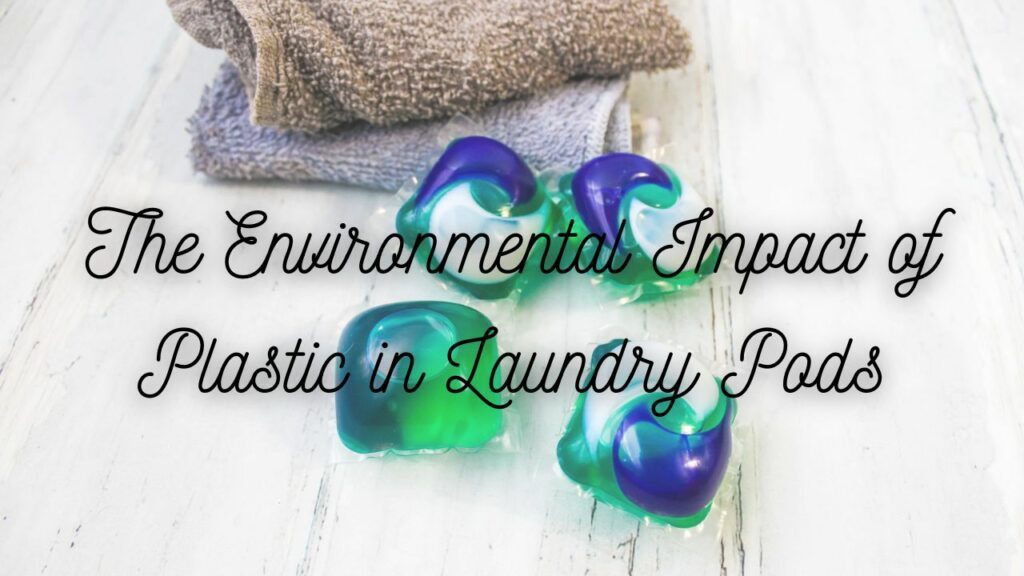Laundry pods, also known as laundry detergent pods or pods, are a type of laundry detergent packaged in a single-use plastic pouch or container. The plastic pouch or container is designed to dissolve in water during the wash cycle, releasing the detergent into the water.
A few different types of plastic may be used in the packaging of laundry pods. Some of the most common types of plastic used in these products include polyvinyl alcohol (PVA), polyethylene, and polypropylene.
When the laundry pod is used as intended, the plastic pouch or container will dissolve in the wash water, and the detergent will be released. However, if the pod is not entirely dissolved, small pieces of plastic may remain in the wash water and potentially end up in the environment, such as rivers and oceans.
It is essential to dispose of laundry pods properly and follow the instructions on the product label to ensure they are used correctly and safely.
Polyvinyl Alcohol (PVA)
Polyvinyl alcohol (PVA) is a synthetic polymer that is used in a variety of applications. It is a white, water-soluble polymer often used as a binder, film former, and lubricant.
One everyday use of PVA is in producing films, such as food packaging films and adhesive tapes. It is also used in the manufacture of textiles, such as nonwoven fabrics, as well as in the production of paper coatings and adhesives.
In addition to its use in producing films and textiles, PVA is a stabilizer and thickener in various products, including paints, coatings, and inks. It is also used as a suspending agent in pharmaceuticals and as a binder in the production of tablets.
PVA is generally considered non-toxic and approved for use in food contact applications by regulatory agencies in many countries. However, it can cause skin irritation in some individuals and should be handled cautiously.

Polyethylene
Polyethylene is a synthetic polymer that is used in a wide variety of applications. It is a light, strong, and flexible plastic known for its toughness, chemical resistance, and low cost. Polyethylene is the most widely produced and used plastic in the world.
There are several different types of polyethylene, including low-density polyethylene (LDPE), linear low-density polyethylene (LLDPE), high-density polyethylene (HDPE), and ultra-high molecular weight polyethylene (UHMWPE). Each type of polyethylene has unique properties and is used in different applications.
Low-density polyethylene (LDPE) is a flexible and lightweight plastic often used in producing films, such as food packaging films and plastic bags. Linear low-density polyethylene (LLDPE) is a more robust and durable plastic often used to produce stretch film, heavy-duty bags, and rotational molding applications.
High-density polyethylene (HDPE) is a strong and stiff plastic often used in producing pipes, bottles, and containers. Ultra-high molecular weight polyethylene (UHMWPE) is a very strong and wear-resistant plastic often used to produce bearings, gears, and other mechanical parts.
Polyethylene is a widely used plastic with many benefits, including its durability, strength, and low cost. However, it is not biodegradable and can take hundreds of years to break down in the environment. As such, it is essential to dispose of polyethylene products properly to minimize their environmental impact.
Polypropylene
Polypropylene (PP) is a synthetic polymer that is used in a wide variety of applications. It is a tough, flexible, and chemically resistant plastic known for its high strength-to-weight ratio. Polypropylene is a type of polyolefin, which means that it is made from a simple olefin or alkene monomer.
Several types of polypropylene include homopolymer polypropylene, copolymer polypropylene, and impact copolymer polypropylene. Every kind of polypropylene has unique properties and is used in different applications.
Homopolymer polypropylene is a tough and rigid plastic often used to produce containers, automotive parts, and industrial products. Copolymer polypropylene is a flexible and impact-resistant plastic often used in making films, fibers, and injection-molded products. Impact copolymer polypropylene is a flexible and impact-resistant plastic often used to create flexible packagings, such as bags and films.
How to Dispose of Laundry Pods
Laundry pods, also known as laundry detergent pods or pods, are a type of laundry detergent packaged in a single-use plastic pouch or container. The plastic pouch or container is designed to dissolve in water during the wash cycle, releasing the detergent into the water.
Proper disposal of laundry pods is essential to ensure that they are used safely and do not end up in an environment where they could potentially cause harm. Here are some general guidelines for disposing of laundry pods:
- Use the pods as directed: Laundry pods should be used as directed on the product label. This will ensure that the plastic pouch or container dissolves entirely in the wash water and the detergent is released into the wash.
- Dispose of the pods properly: After use, the pods should be properly disposed of in the trash. Do not flush the pods down the toilet or rinse them down the sink, as this could lead to blockages in plumbing systems.
- Keep the pods out of reach of children and pets: Laundry pods can be harmful if ingested, so it is essential to keep them out of reach.
- Recycle the packaging: If the packaging for the laundry pods is made of recyclable materials, such as cardboard or plastic, it can be placed in the recycling bin. However, the plastic pouch or container should not be recycled, as it is designed to dissolve in water.
By following these guidelines, you can help ensure that laundry pods are used safely and disposed of properly, minimizing their environmental impact.
Conclusion
In summary, we discussed plastic in laundry pods and the different types of plastic that may be used, including polyvinyl alcohol (PVA), polyethylene, and polypropylene. We also discussed the importance of adequately disposing of laundry pods to minimize their environmental impact.
Laundry pods should be used as directed on the product label, adequately disposed of in the trash, kept out of reach of children and pets, and the packaging should be recycled if possible. By following these guidelines, we can help ensure that laundry pods are used safely and disposed of properly, minimizing their environmental impact.

